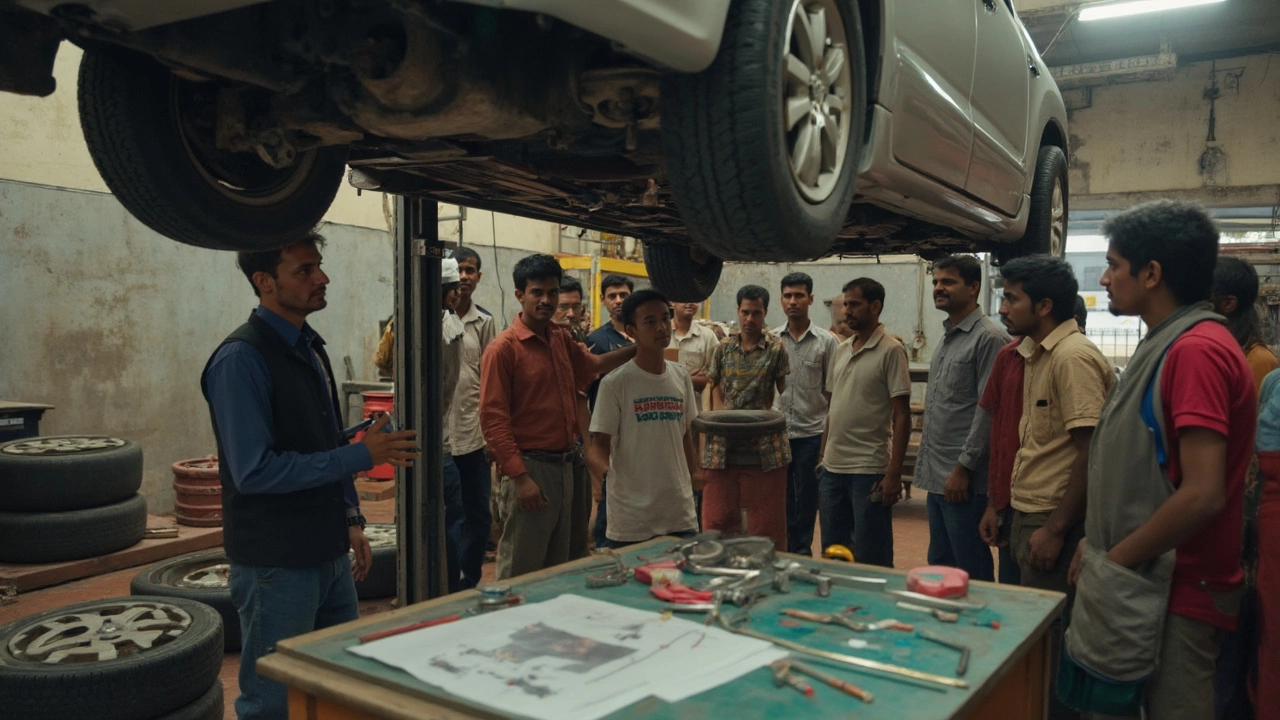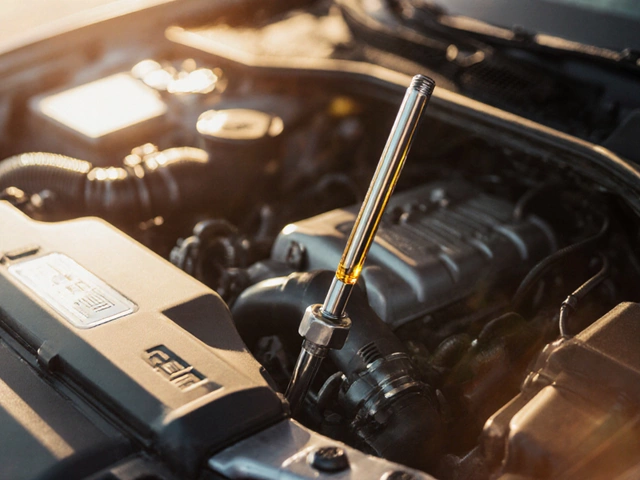Ever felt like you're riding a rollercoaster while driving? It might be time to check your shocks and struts. These components are crucial for keeping your drive smooth and your car stable. When they're worn out, you could feel like you're bouncing all over the place.
But it's not just about comfort—worn shocks and struts can mess with your vehicle's handling and even impact your safety. So, how do you know when they're shot? For starters, if your car's diving nose-first every time you brake, that's a big clue. Those squeaky, clunky noises on rough roads might be your suspension crying for help.
Keep an eye on uneven tire wear too. It's often a sign that your shocks or struts are on their last legs. We'll go into more detail about these symptoms, but for anyone feeling like they're driving a trampoline, it's time for a closer look at your suspension.
- Symptoms of Worn Shocks or Struts
- How Shocks and Struts Work
- DIY Checks for Suspension Issues
- When to See a Mechanic
Symptoms of Worn Shocks or Struts
Wondering if banging sounds and bumpy rides are part of car life? They don't have to be. They're likely symptoms of worn-out shocks or struts—key suspension parts that affect your car's performance.
1. Bumpy Rides
If you've lately felt like you're off-roading on a city street, it could be time to check your suspension. With good shocks and struts, your car transitions smoothly over bumps. Without them, every pothole feels like a crater.
2. Nose Dives While Braking
Ever notice the front end of your car dipping when you hit the brakes? It's a classic sign of worn shocks or struts. The suspension isn't properly controlling the weight transfer during braking.
3. Uneven Tire Wear
Uneven or accelerated tire wear hints at suspension trouble. Shocks and struts keep tires flat on the road for even wear. Worn parts can make your tires go bald faster, costing you big bucks in premature replacements.
4. Leaking Fluid
Inspect your shocks and struts visually. If they look oily or wet, it means fluid is leaking, indicating they're worn out. Leaks drastically reduce the components' effectiveness.
"Suspension systems play a crucial role in vehicle stability and control," says Mike Allen, a senior automotive editor. "Worn shocks and struts can significantly impact your driving experience."
5. Vibrations at High Speeds
Felt a weird vibration or shaking at higher speeds? It can be a result of bad shocks and struts failing to stabilize the vehicle.
6. Steering Issues
Find yourself battling the steering wheel to keep it straight? Worn suspension parts can disrupt handling, making your car feel like it's lost its sense of direction.
Keep an eye out for these symptoms so you can tackle issues early. Your safety and your wallet will thank you.
How Shocks and Struts Work
So, what's the deal with shocks and struts? Simply put, they're the unsung heroes of your car's suspension parts system, keeping things balanced and smooth. While they sound similar, they play slightly different roles.
Shocks
Shocks, or shock absorbers, are all about controlling the bounce. Think of them as the steady hand that keeps your tires in contact with the road, no matter what bumps you hit. They manage the spring's movement without adding to the structural support. Inside, they use oil and pistons to dampen the shock caused by road impacts. Fun fact: an average shock absorber lasts about 4-5 years, depending on your driving conditions.
Struts
Struts, on the other hand, are like the multi-taskers of the family. They not only absorb shocks but also act as a structural part of the suspension system. While shocks just manage the motion, struts help hold up the car's weight, maintaining its alignment. This dual function is why they’re usually found in the front suspension but can be in the rear as well in some vehicles.
Both parts are key for vehicle control. If they're not working right, your car might feel unstable, especially around corners or in crosswinds. It's like trying to balance on a wobbly stool—no fun, and not safe.
Importance of Regular Checks
Regular checks are crucial. It's more than just bouncing around; worn shocks or struts can dramatically extend your braking distance. A study showed that with 50% wear, stopping distance increases by as much as 3-5 meters. That's the split-second difference between stopping in time and a fender bender.
In short, keeping your car maintenance up-to-date with these checks can save you a world of trouble and a pretty penny. Remember, a smoother ride isn't just comfy—it's safer too.

DIY Checks for Suspension Issues
Think your car's shocks or struts might be on the fritz? Before rushing to the mechanic, you can run some simple checks yourself. Don't worry; you don't need to be a car expert for this.
Look for Visible Signs
Start by doing a visual inspection. You want to look for leaks. Shocks and struts are hydraulic, and if they're leaking fluid, it's a red flag that they're wearing out. Jack up your car safely, of course, and check around the suspension area for oily patches or puddles.
"A little DIY inspection can go a long way in car maintenance," says veteran mechanic Jake Walters. "Regular checks help catch issues early before they become costly problems."
Bounce Test
This one's a classic and super easy to do. Push down hard on the corner of your car. If it bounces more than 2-3 times, your shocks or struts are likely shot.
Check Your Tires
Take a good look at your tires. Uneven wear usually suggests suspension troubles. Pay attention to bumpy spots on the tire surface.
Listen and Feel While Driving
When you drive, listen for noises like clunking or squeaking that could come from a loose or worn suspension. Feel for vibrations or excessive body roll when taking turns or hitting bumps.
Quick List of Checks
- Inspect for oil leaks around the struts/shocks.
- Perform the bounce test for immediate feedback.
- Check tires for uneven wear patterns.
- Pay attention to abnormal noises or handling issues while driving.
If any of these tests point to an issue, it's probably time to get a professional opinion. While DIY checks are great, sometimes it's better to let a pro handle the more complex stuff.
When to See a Mechanic
Sometimes, figuring out what's happening under your car's hood is best left to the pros. If your ride feels like it's fallen out of sync, a visit to the mechanic might be in order. Why? Because identifying whether it's the shocks or struts causing trouble isn't always straightforward.
Persistent Symptoms
If you've been dealing with that bumpy ride for too long, or if the nose dive during braking seems to worsen, it's time to let a mechanic take a look. They have the tools and know-how to diagnose the issue properly. Neglecting it might cause further wear on other components.
Unusual Noises
That clunking or squeaking noise over every bump is a key sign your suspension system needs some love. If the noise becomes a regular feature on your drives, a mechanic can pinpoint the source. Waiting too long could potentially damage parts that were otherwise salvageable.
Visual Indicators
Visible oil leakage around the shocks or struts is another signal. They might look OK to the untrained eye, but a mechanic can determine if they're past their prime. Remember, compromised suspension parts not only impact comfort but also your vehicle's alignment.
Professional Inspection Benefits
Getting your car checked by a certified mechanic ensures that any problems are caught early. They’ll assess whether you need a quick fix or a full replacement, possibly saving you money down the line.
| Symptom | Potential Problem |
|---|---|
| Uneven Tire Wear | Misaligned suspension |
| Nose Dive | Worn struts |
| Loud Noises | Damaged shocks |
Treat any strange feelings or sounds from your car as urgent calls to your mechanic. It's better to have them checked out than to risk long-term damage or more expensive repairs down the road.











Write a comment